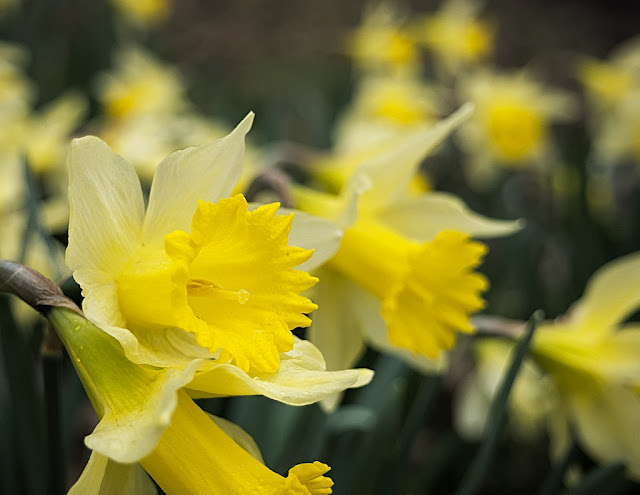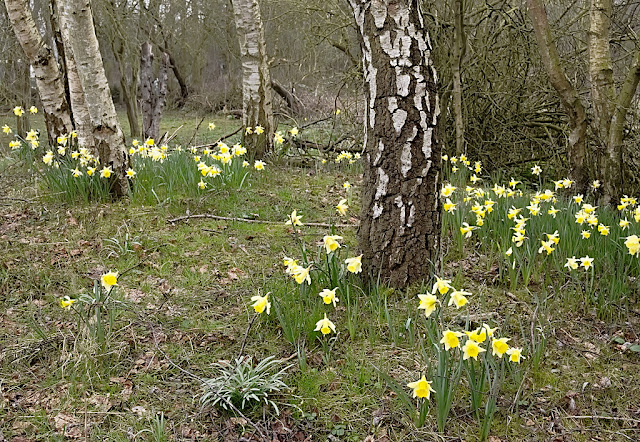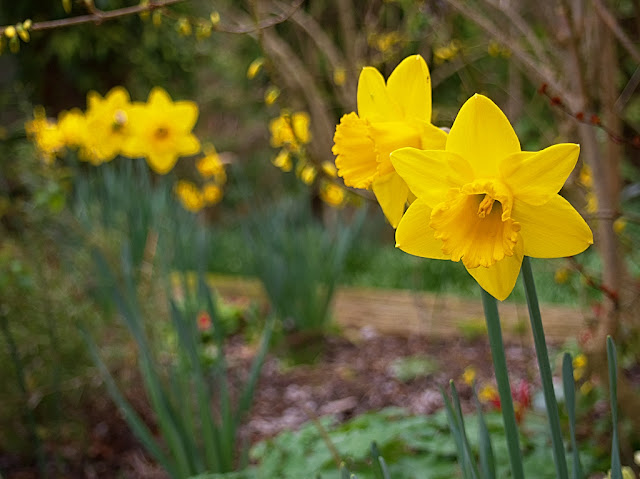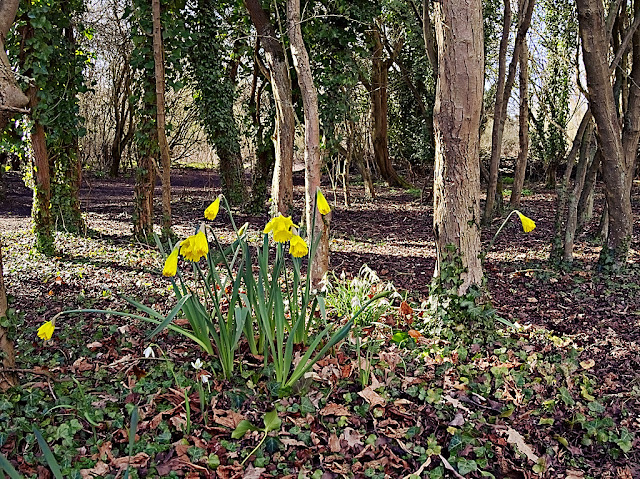 |
| A Fanfare for Spring - 12 March 2017 Outside the Visitor Centre, a group of daffodils at their best welcome the visitor. |
From Hell to Life Preserver
These
first flowers of spring are seen as a symbol of rebirth, but that has
not always been the case – in ancient Greek mythology, Wordsworth's
gleeful blooms were seen as flowers from hell. Pliny claims that
daffodils grew on the banks of the underworld river Acheron to cheer
the passing souls. In another myth, daffodils were white until Pluto dragged Persephone, the worman he loved, down into his underworld kingdom and turned the bunch of the flowers she was carrying yellow.
Egyptians also included daffodils in funeral wreaths.
The daffodil fared little better under the Romans who introduced the flowers to England in the mistaken belief that their sap could help to heal wounds; in truth daffodil sap has entirely the opposite effect and acts as an irritant. More macabrely, Roman soldiers carried a bunch of daffodil bulbs around with them to be eaten if they were mortally wounded in battle. The bulbs are both narcotic and highly poisonous, so presumably the men thought that they would die peacefully and painlessly.
Over the ensuing centuries, daffodils have gathered a lot of folk lore, some good and some bad. I find it interesting to speculate on how these various beliefs started, and how they became established and spread. We are used to daily headlines telling us what to eat and what not to eat for a long and healthy life. And we know where these stories come from: scientists have studied the diets of thousands, if not millions of people, over many years; then analysed the results on powerful computers to come to their conclusions. Even then, the more sceptical of us wonder how they could isolate the effects of one food from a mass of diets, different life styles, different genetic susceptibilities, etc. Our predecessors had access to none of this.
 |
| Naturalised Flowers - 12 March 2017 Clumps of daffodils naturalised below the birches beside the car park Their bright yellow flowers dominate the otherwise drab scenery |
Take for instance, the belief that to deliberately avoid trampling on daffodils is to bring good luck. Is this no more than a lord of the manor trying to preserve his view from his dining room window; a sort of 'keep off the grass' notice for an illiterate and superstitious population?
Or what about the stricture never to give a single daffodil, always give a bunch, because to bring a single daffodil into the house will bring bad luck? Is this just a way of saying don't be mean?
But
good luck and bad luck are very general and fuzzy ideas, whose
interpretation depends on how someone looks at life. Yet, some
beliefs are quite specific: to bring daffodils into a house with
poultry in it would stop the eggs hatching or the hens laying any
more eggs. How did this come about? Did farmer Giles walk into his
local pub one night, and tell everyone that his hens had stopped
laying eggs ever since his wife brought those daffodils into the
house? Did someone else vaguely recall that something similar had
happened to old Martha in the next village? Then as the tale spread,
did others remember similar incidents – naturally forgetting all
the countless bunches of daffodils that had had no effect whatsoever
on laying chickens? So a legend was born.
 |
| Sensory Garden - 12 March 2017 The golden trumpets of daffodils dominate the central bed in the Sensory Garden |
Wordsworth, of course, reversed these bleak views of the daffodil with his famous celebration of the plant. Now, in the twenty first century, this flower once associated with
death is now being used to improve life: since the late 1990's
daffodils have been grown commercially for their galanthamine
content, a substance which has been shown to slow down the progress
of Alzheimer's disease.
Further Reading
I found the following websites helpful:
Daffodils
Daffodil Magic, Legend and Myth
Daffodil Origins, Lore, and Traditions
The Daffodil Myths, Legends and Old Tales
Meaning and Symbolism of Narcissus / Daffodils
Common Garden Flowers: Folklore of Bluebells, Daffodils and Hydrangeas
Drug Hopes Rest on a Host of Daffodils
Next: Blackthorn
Daffodils
Daffodil Magic, Legend and Myth
Daffodil Origins, Lore, and Traditions
The Daffodil Myths, Legends and Old Tales
Meaning and Symbolism of Narcissus / Daffodils
Common Garden Flowers: Folklore of Bluebells, Daffodils and Hydrangeas
Drug Hopes Rest on a Host of Daffodils
Next: Blackthorn


No comments:
Post a Comment